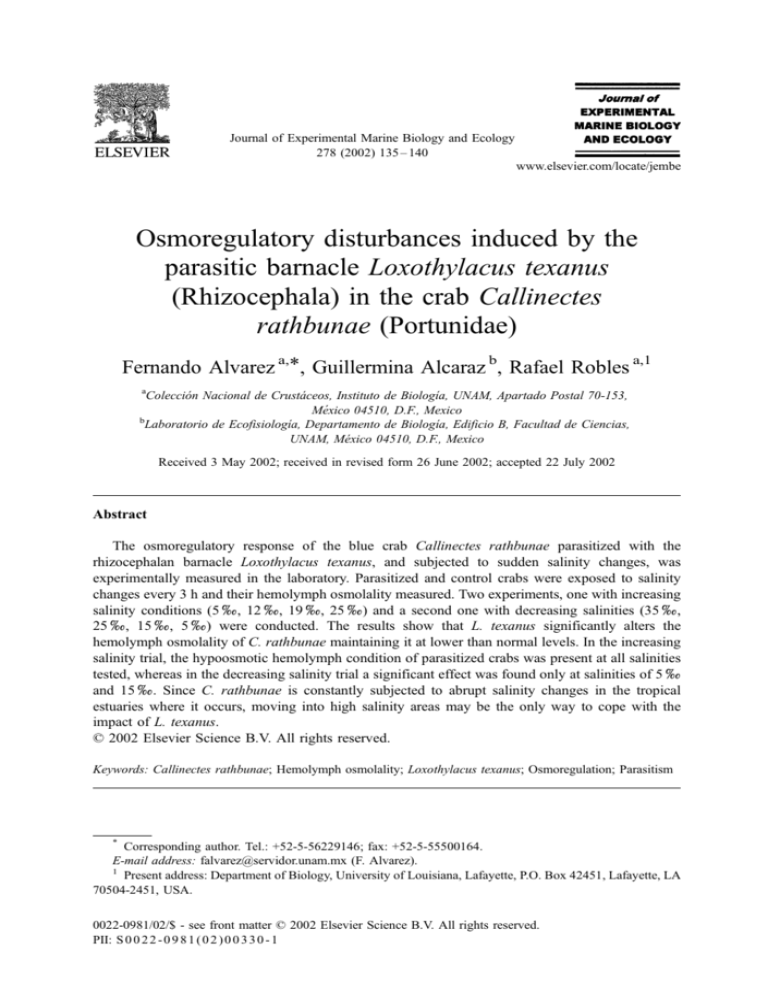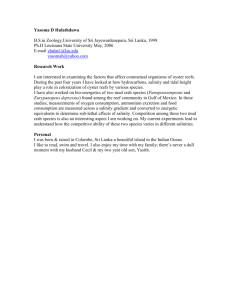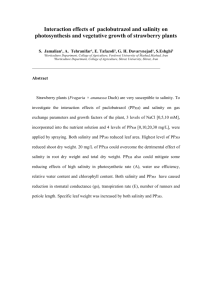
Journal of Experimental Marine Biology and Ecology
278 (2002) 135 – 140
www.elsevier.com/locate/jembe
Osmoregulatory disturbances induced by the
parasitic barnacle Loxothylacus texanus
(Rhizocephala) in the crab Callinectes
rathbunae (Portunidae)
Fernando Alvarez a,*, Guillermina Alcaraz b, Rafael Robles a,1
a
Colección Nacional de Crustáceos, Instituto de Biologı́a, UNAM, Apartado Postal 70-153,
México 04510, D.F., Mexico
b
Laboratorio de Ecofisiologı́a, Departamento de Biologı́a, Edificio B, Facultad de Ciencias,
UNAM, México 04510, D.F., Mexico
Received 3 May 2002; received in revised form 26 June 2002; accepted 22 July 2002
Abstract
The osmoregulatory response of the blue crab Callinectes rathbunae parasitized with the
rhizocephalan barnacle Loxothylacus texanus, and subjected to sudden salinity changes, was
experimentally measured in the laboratory. Parasitized and control crabs were exposed to salinity
changes every 3 h and their hemolymph osmolality measured. Two experiments, one with increasing
salinity conditions (5x, 12x, 19x, 25x) and a second one with decreasing salinities (35x,
25x, 15x, 5x) were conducted. The results show that L. texanus significantly alters the
hemolymph osmolality of C. rathbunae maintaining it at lower than normal levels. In the increasing
salinity trial, the hypoosmotic hemolymph condition of parasitized crabs was present at all salinities
tested, whereas in the decreasing salinity trial a significant effect was found only at salinities of 5x
and 15x. Since C. rathbunae is constantly subjected to abrupt salinity changes in the tropical
estuaries where it occurs, moving into high salinity areas may be the only way to cope with the
impact of L. texanus.
D 2002 Elsevier Science B.V. All rights reserved.
Keywords: Callinectes rathbunae; Hemolymph osmolality; Loxothylacus texanus; Osmoregulation; Parasitism
*
Corresponding author. Tel.: +52-5-56229146; fax: +52-5-55500164.
E-mail address: falvarez@servidor.unam.mx (F. Alvarez).
1
Present address: Department of Biology, University of Louisiana, Lafayette, P.O. Box 42451, Lafayette, LA
70504-2451, USA.
0022-0981/02/$ - see front matter D 2002 Elsevier Science B.V. All rights reserved.
PII: S 0 0 2 2 - 0 9 8 1 ( 0 2 ) 0 0 3 3 0 - 1
136
F. Alvarez et al. / J. Exp. Mar. Biol. Ecol. 278 (2002) 135–140
1. Introduction
The estuarine habitat is characterized by strong diurnal fluctuations in salinity and
temperature. Many estuarine crustacean species are characterized by their tolerance to
these constant changes. In particular, Callinectes sapidus Rathbun, and Callinectes
rathbunae Contreras, are estuarine crabs recognized as euryhaline due to their ability to
tolerate a wide range of salinity concentrations (Rosas et al., 1986). They are hyperosmoregulators, able to maintain a high and constant hemolymph osmolality while the
surrounding medium becomes diluted (Pequeux, 1995). However, differences in osmoregulatory capacities among species may result in different distribution patterns within the
estuary (Guerin and Stickle, 1997). In the coastal lagoons of the southwestern Gulf of
Mexico, three species of Callinectes coexist, each one preferentially occupying a different
section inside the lagoon, depending on the salinity conditions: Callinectes similis
Williams, in the high salinity (22 – 35x) inlet areas; C. sapidus in the medium to high
salinity areas (13 – 25x) and C. rathbunae in the low to medium salinity areas (0 –20x)
(Rosas, 1989).
Besides the physiological stress produced by the changing salinity conditions, C.
sapidus and C. rathbunae from the Gulf of Mexico have to face an additional burden
imposed by the parasitic barnacle Loxothylacus texanus. Rhizocephalans can induce longterm effects on their hosts, such as sterilization, cessation of molt and growth (Høeg,
1995), as well as physiological and behavioral changes that may decrease the individual
performance of organisms (Innocenti et al., 1998). Laboratory experiments have shown
that L. texanus induces increased energetic expenses in C. rathbunae maintained in
salinities ranging from 5xto 25x(Robles et al., 2002), suggesting that osmoregulatory
processes might be disturbed by the parasite. The objective of this study was to determine
if the osmoregulatory response of C. rathbunae carrying mature L. texanus was altered in
relation to control, unparasitized individuals when exposed to abrupt salinity changes. The
salinity values tested correspond to those that are commonly found in the estuaries of the
Gulf of Mexico.
2. Materials and methods
C. rathbunae, parasitized and unparasitized, were obtained from local fishermen in the
Alvarado lagoon system. The crabs were transported to the Institute of Biology,
Universidad Nacional Autónoma de México (UNAM), in Mexico City, where they arrived
within 6 h of collection. Crabs were placed in recirculating water systems provided with
air and biological and mechanical filters. Alvarado lagoon water was gradually replaced
with artificial marine water (Instant OceanR). During the maintenance, acclimation, and
experimental periods, water temperature was maintained at 27 jC and the light/dark
regime was 12:12 h. Crabs were fed fresh fish everyday; after 2 h, the remaining food was
removed from the tanks.
Crabs were grouped into two groups: control, composed by nonparasitized crabs and
experimental, composed by crabs with one mature, fully grown parasite externa. Two sets
of experiments were conducted. For the first experiment crabs (23 control, 5 parasitized)
F. Alvarez et al. / J. Exp. Mar. Biol. Ecol. 278 (2002) 135–140
137
were acclimated for 15 days to a salinity of 5x. After this period, crabs were sequentially
exposed to increasing salinities from 5xto 12x, to 19xand to 25x, remaining for 3 h
in each salinity. After each 3-h exposure period, 20 Al of hemolymph were drawn with a
syringe from each crab through the coxal arthrodial membrane of the fifth pair of legs. The
sample was immediately analyzed using an Advanced model 3300 micro-osmometer. Once
the hemolymph samples were taken, water salinity was gradually increased to the next
condition and the procedure repeated.
In the second experiment, the crabs (6 control, 23 parasitized) were exposed to
decreasing salinity conditions. Acclimation lasted for 15 days at 35xsalinity. The
experimental procedure was the same as in the previous experiment, except that the
salinity decreased from 35xto 25x, to 15xand to 5x. As before, after 3 h of
exposure to each salinity, a sample of 20 Al of hemolymph was taken from each crab and
immediately analyzed for osmotic pressure.
2.1. Statistical analysis
Both experimental designs included repeated testing of the same individuals; thus,
data were not independent. A Repeated Measures Analysis of Variance (RM-ANOVA)
was used to test the effect of parasitism, water salinity, and the interaction of both
variables on hemolymph osmolality of C. rathbunae. Presence of the parasite was used
as a fixed factor, while salinity was the repeated measure. Data were examined for
normality using visual inspections, and Levene’s test was performed to ensure homogeneity of variances. The assumption of circularity of the variance– covariance matrix was
tested with a Mauchly test of sphericity (von Ende, 1993). If needed, Huynh-Feldt’s
adjusted probabilities for F were used (von Ende, 1993). After obtaining significant
differences, means were compared using a multiple comparison test (least significant
difference, LSD) to test for significant differences between pairs of means (control vs.
parasitized). Both RM-ANOVA and LSD analysis were conducted independently for
both experiments. All the analysis were conducted with the computer program
STATISTICAn.
3. Results
The matrix differed from circularity for the salinity factor in both increasing (W = 0.370,
v2 = 24.58, P < 0.001) and decreasing experiments (W = 0.271, v2 = 29.67, P < 0.001).
Therefore, we used adjusted probabilities to calculate F for within subject factor in both
experiments.
The survival of control and parasitized crabs during the increasing salinity trial was
100%. With increasing salinity, both parasite presence and water salinity had a significant
effect on hemolymph osmolality (F1,26 = 14.52, P < 0.001; F2,53 = 85.68, P < 0.001);
however, there was no interaction between them (F3,78 = 0.49, P = 0.69). Within each
treatment, although osmolality increased slightly, no significant differences were observed
at 5xand 12xsalinities. However, there was an increment in osmolality of both groups of
crabs at 19xand 25xsalinities (LSD, P < 0.05) (Fig. 1). Hemolymph osmolalities of
138
F. Alvarez et al. / J. Exp. Mar. Biol. Ecol. 278 (2002) 135–140
Fig. 1. Hemolymph osmolalities of C. rathbunae, control and parasitized with the rhizocephalan barnacle L.
texanus, subjected to increasing and decreasing salinities.
control crabs at all salinities were significantly higher than those of parasitized crabs,
independent of water salinity (LSD, P < 0.05).
In the decreasing salinity experiment, survival of control crabs was 100% with three
parasitized crabs dying when the salinity changed from 15xto 5x. Parasite and salinity
had a significant effect on hemolymph osmolality (F1,24 = 4.90, P = 0.036; F2,43 = 424.08,
P < 0.001) with a significant interaction between them (F3,72 = 8.94, P < 0.001). In both
groups of crabs, the decrease in salinity was followed by a decrease in hemolymph
osmolality (LSD, P < 0.01) (Fig. 1). At 35xand 25xsalinities, no significant differences were found. At 15xand 5xsalinities, control crabs maintained a significantly
higher hemolymph osmolality than parasitized crabs (LSD, P < 0.01).
4. Discussion
The results show that L. texanus significantly affects the osmoregulation in C. rathbunae
when exposed to changing salinity conditions. In the two experiments conducted with
increasing and decreasing salinities, parasitized crabs had lower hemolymph osmolalities
than control crabs. Although no specific studies have been carried out to test the effect of a
lower hemolymph osmolality in the performance of C. rathbunae, experiments using other
species of crabs show that a lower than normal hemolymph osmolality may result in poor
performance, inactive behavior and even death (McGaw et al., 1999).
Within the salinity range tested, control and parasitized crabs behaved as hyperosmoregulators, as the osmotic concentrations of the hemolymph were higher than those
of the water. The isosmotic point of both control and parasitized crabs was close to the
higher salinity tested in both trials (25xin increasing salinity and 35xin decreasing
salinity).
F. Alvarez et al. / J. Exp. Mar. Biol. Ecol. 278 (2002) 135–140
139
Although unparasitized C. rathbunae are capable of regulating their internal fluids in
low salinity in order to improve their individual performance and maintain a high level of
activity, parasitized individuals may exhibit an altered behavior and distribution pattern.
Migration of parasitized crabs towards high salinity areas near the inlets may be a strategy
to reduce the osmotic gradient between their internal fluids and the water, thus reducing
the energetic expenses imposed by the parasite. We can predict, based on the decreasing
salinity results, that once a crab has reached a high salinity area it will be unlikely for it to
return to low salinity areas since below 25xit will experience physiological stress.
In contrast to the results of Robles et al. (2002), where parasitized C. rathbunae
consumed significantly more oxygen than control crabs at all salinities ranging from 5x
to 25x, the results presented herein show that the effect of a lower than normal
hemolymph osmolality increases with decreasing salinity. The results of the two studies
combined suggest that although at high salinities L. texanus represents a significant
metabolic load for C. rathbunae it does not affect its performance since its osmoregulation
is not affected, while at low salinities the metabolic load is associated with an inability to
maintain the hemolymph osmolality at normal levels.
Mixed results have been obtained in previous studies that compared the hemolymph
osmolality of control and rhizocephalan parasitized crabs. Among the Alaskan king crabs
parasitized by Briarosaccus callosus only the blue king crab (Paralithodes platypus) was
found to have a significantly lower hemolymph osmolality when parasitized, while no
effect was detected for the red and golden king crabs (Shirley et al., 1986). In the estuarine
Rhithropanopeus harrisii, no effect was detected when parasitized by Loxothylacus
panopaei over a wide range of salinities (1– 30x) (Reisser and Forward, 1991). These
two studies differ from ours in that the crabs were acclimated for long periods of time to
the test salinities before obtaining the hemolymph samples.
Shirley et al. (1986) explained the lower than normal hemolymph osmolality of the
blue king crab as a hormonal imbalance caused by the parasite, associated with a lower
than normal sodium concentration; while the lack of effect in the red and golden king
crabs was attributed to a hypothetical immune mechanism that would counteract the
negative effects of the parasite. Reisser and Forward (1991) did not discuss why no
osmoregulatory alteration was found in R. harrisii carrying L. panopaei. Although they
recognized that the parasite represented an unregulated channel through which water and
ions could flow in and out of the crab, they proposed that crab and parasite had discrete
circulatory systems.
While no single mechanism can explain the results obtained in the three studies, it is
clear that rhizocephalans cannot osmoregulate on their own, having to either osmoconform in high salinities or utilize the host’s osmoregulatory mechanisms in low salinity.
In this way, at low salinities the intake by the parasite of some of the host’s hemolymph
components would tend to lower the host hemolymph osmolality. Reisser and Forward’s
(1991) results suggest that a long enough acclimation period (7 to 9 days) would tend to
balance the host crab and parasite hemolymph osmolalities, independently from the
external medium concentration. However, in the case of C. rathbunae which is
constantly subjected to abrupt salinity changes in the tropical estuaries where it occurs,
moving into high salinity areas may be the only way to cope with the impact of L.
texanus.
140
F. Alvarez et al. / J. Exp. Mar. Biol. Ecol. 278 (2002) 135–140
Acknowledgements
This study was conducted with funding from Grants 3289P-N from CONACYT and
IN210595 from DGAPA, UNAM to Fernando Alvarez. [SS]
References
Guerin, J.L., Stickle, W.B., 1997. A comparative study of two sympatric species within the genus Callinectes:
osmoregulation, long-term acclimation to salinity and the effects of salinity on growth and moulting. J. Exp.
Mar. Biol. Ecol. 218 (2), 165 – 186.
Høeg, J.T., 1995. The biology and life cycle of the Rhizocephala (Cirripedia). J. Mar. Biol. Assoc. U.K. 75,
517 – 550.
Innocenti, G., Vannini, M., Galil, B.S., 1998. Notes on the behaviour of the portunid crab Charybdis longicollis
Leene parasitized by the rhizocephalan Heterosaccus dollfusi Boschma. J. Nat. Hist. 32 (10 – 11), 1577 – 1585.
McGaw, I.J., Reiber, C.L., Guadagnoli, J.A., 1999. Behavioral physiology of four crab species in low salinity.
Biol. Bull. 196, 163 – 176.
Pequeux, A., 1995. Osmotic regulation in crustaceans. J. Crustac. Biol. 15 (1), 1 – 60.
Reisser, C.E., Forward Jr., R.B. 1991. Effect of salinity on osmoregulation and survival of a rhizocephalan
parasite, Loxothylcaus panopaei, and its crab host, Rhithropanopeus harrisii. Estuaries 14 (1), 102 – 106.
Robles, R., Alvarez, F., Alcaraz, G., 2002. Oxygen consumption of the crab Callinectes rathbunae parasitized
by the rhizocephalan barnacle Loxothylacus texanus as a function of salinity. Mar. Ecol., Prog. Ser. 235,
189 – 194.
Rosas, C., 1989. Aspectos de la ecofisiologı́a de las jaibas Callinectes sapidus, Callinectes rathbunae y Callinectes similis, de la zona sur de la laguna de Tamiahua, Veracruz (Crustacea: Decapoda: Portunidae). PhD
Thesis, Facultad de Ciencias, UNAM, 220 pp.
Rosas, C., Lázaro-Chávez, E., Gomez-Aguirre, S., 1986. Efecto de las variaciones de la salinidad sobre la tasa
respiratoria de dos especies de jaibas: Callinectes sapidus y Callinectes rathbunae, en la laguna de Tamiahua,
Veracruz, México. Rev. Investig. Mar. 7 (2), 71 – 78.
Shirley, S.M., Shirley, T.C., Meyers, T.R., 1986. Hemolymph responses of Alaskan king crabs to rhizocephalan
parasitism. Can. J. Zool. 64, 1774 – 1781.
von Ende, C.N., 1993. Repeated measures analysis: growth and other time dependent measures. In: Scheiner,
S.M., Gurevich, J. (Eds.), Design and Analysis of Ecological Experiments. Chapman & Hall, New York,
pp. 113 – 137.







